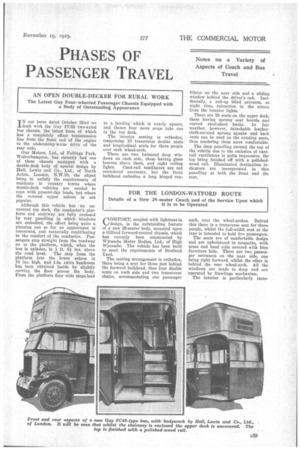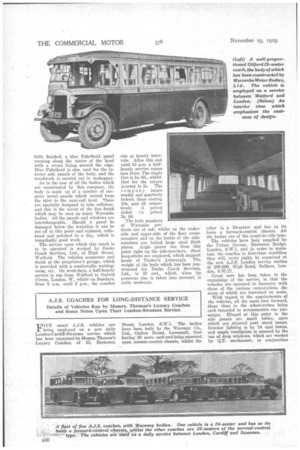PHASES OF PASSENGER TRAVEL
Page 73

Page 74

Page 75

If you've noticed an error in this article please click here to report it so we can fix it.
AN OPEN DOUBLE-DECKER FOR RURAL WORK
The Latest Guy Four-wheeled Passenger Chassis Equipped with a Body of Outstanding Appearance
IN our issue dated October 22nd we dealt with the Guy FC48 two-axled bus chassis, the latest form of which has a completely offset transmission line from the front end of the engine to the underslung-worm drive of the rear axle.
Guy Motors, Ltd., of Fallings Park, Wolverhampton, has recently had one of these chassis equipped with a double-deck body of special design by Hall, Lewis and Co., Ltd., of North Acton, London, N.W.10, the object being to satisfy the requirements of residents in country towns where double-deck vehicles are needed to cope with present-day loads, but where the covered upper saloon is nOt popular.
Although this vehicle has an uncovered top deck, the conductor's platform and stairway are fully enclosed by rear panelling in which windows are embodied, the effect being quite a pleasing one so far as appearance is concerned, and materially contributing to the comfort of the conductor. Passengers step straight from the roadway on to the platform, which, when the bus is unladen, is 1 ft. 6i ins, above the road level. The step from the platform into the lower saloon is 10 ins, high, and 1-in. extra headroom has been obtained inside by slightly curving the floor across the body. From the platform four wide steps lead to a landing which is nearly square, and thence four more steps take one to the top deck.
The interior seating is orthodox, coniprising 10 transverse double seats and longitudinal seats for three people over each wheel-arch.
There are two balanced drop windows on each side, these having glass louvres above them, and eight ceiling lights. Cant-rail ventilators are not considered necessary, but the front bulkhead embodies a long hinged yen
COMFORT, coupled with lightness in design, is the outstanding feature of a new 29-seater body, mounted upon a Gilford forward-control chassis, which has recently been constructed by Wycombe Motor Bodies, Ltd., of High Wycombe. The vehicle has been built to meet the requirements of Scotland Yard.
The seating arrangement is orthodox, there being a seat for three just behind the forward bulkhead, then four double seats on each side and two transverse chairs, accommodating one passenger Hinter on the near side and a sliding window behind the driver's cab. Incidentally, a roll-up blind prevents, at night time, .refraction in the screen from the interior lights.
There are 28 seats, on the upper deck, these having sprung seat boards and curved steel-sheet backs. In fair weather, however, detachable leathercloth-covered sprung squabs and back rests can be used on the existing seats, thus rendering them more comfortable.
The deep panelling around the top of the vehicle due to the omission of contrail ventilators is quite impressive, the top being finished off with a polishedwood rail. Illuminated destination indicators are incorporated in this panelling at both the front and the rear.
each, over the wheel-arches. Behind this there is a transverse seat for three people, whilst the full-width seat at the rear is intended to hold five passengers.
The seats are of comfortable design and are upholstered in moquette, with arms and bead rolls covered with blue furniture hide. There are two passenger entrances on the near side, one being right forward, whilst the other is behind the rear wheel-arch. All the windows are made to -drop and are operated by Rawlings mechanism.
The interior is particularly taste fully finished, a blue Fabrikoid panel running along the centre pf the head with a cream lining around the edge. Blue Fabrikoid is also used for the interior side panels of the body, and the woodwork is carried out in mahogany.
As in the case of all the bodies which are constructed by this company, the body is made up of a number of onepiece metal panels which extend from the skirt to the cant-rail level. These are specially designed to take cellulose, and this is the secret of the fine finish which may be seen on many Wycombe bodies. All the panels and windows are interchangeable. Should a panel be damaged below the waistline it can be cut off at this point and replaced, cellulosed and polished in a day, which is remarkably good work.
The service upon which this coach is to be operated is worked by Bucks Coach Services, Ltd., of High Street, Watford. The vehicles commence and finish at the proprietor's garage, which is provided with a comfortable waitingroom, etc. On week-days, a half-hourly service is run from Watford to Oxford Circus, London, W., whilst on Sundays, from 9 a.m. until 2 p.m., the coaches
FIVE smart A.J.S. vehicles are being employed on a new daily London-Cardiff-Swansea service which has been organized by Messrs. Thomas's Luxury Coaches, of 23, Eccleston run at hourly intervals. After this and until 10 p.m. a halfhourly service comes into force. The single fare is 1s. 6d., whilst that for the return journey is 2s. The company issues weekly and quarterly tickets, these costing 10s. and £5 respectively. A period ticket is priced 2s. 6d.
The body members of Wycombe products are of ash, whilst on the underside and upper-side of the floor crossmembers and on the inside of the sidemembers are bolted large steel flitch plates. Angle pieces run from this point right up the side-members. Steel hoop-sticks are employed, which support heads of Tucker's Armourply. The weight of the body which has been constructed for Bucks Coach Services, Ltd., is 33 cwt., which, when its generous size is taken into account, is quite moderate.
Street, London, S.W.1. The bodies have been built by the Waveney Co., Ltd., Oniton Broad, Lowestoft, four having 20 seats each and being mounted upon normal-control chassis, whilst the
other is a 24-seater and has as its basis a forward-control chassis. All the bodies are of the coupe-de-vine type.
The vehicles have been supplied by the Palace Garage, Eccleston Bridge, London, S.W.1, and in order to maintain the coaches in first-class condition they will, every night, be examined at the new A.J.S. London service station at 260-266, High Road, Balham, London, S.W.17. Great care has been taken in the organizing of the service, in that the vehicles are operated in harmony with those of the various corporations, the areas of which are traversed en route.
With regard to the appointments of the vehicles, all the seats face forward, those elose to the wheel-arches being each intended to accommodate one passenger. Hinged at this point to the side panels are small tables, upon which are situated neat stand lamps. Interior lighting is by 14 opal lamps, and ample ventilation is assured by the use of drop windows, which arc worked by Q.T. mechanism, in conjunction
with three Airvac ventilators in the roof. Luggage is carried on the rear of the head, as well as in lockers along the skirts.
The interior colour scheme has been carefully considered. The seats are upholstered in black and grey moquette, whilst the lining of the roof is carried out in light grey head cloth. The floor is covered with granite-pattern linoleum. Purple curtains are supplied, ip OR some time past Mr. George Towers, the managing director of (3estrian Motor Services, who is also a director of the . General County Omnibus Co., Ltd.; a concern which operates extensively in the Newcastle and Durham areas, • has concentrated on the operation of a long-distance service between London and Glasgow. This service, we are told, has proved particularly sliccessful, , Six Gifford normal-control. vehicles are used, live of which are equipped these being specially coloured to blend with the exterior scheme. This is carried out chiefly in mauve, the upper part of the body being of a dark shade, whilst the lower portion is of a paler tone. These two sections are divided by a cream waist rail, which is neatly picked out with a black moulding having a gold line running through it. The weight of each body is approximately 35-37 cwt.
with bodies constructed by Duple Bodies and Motors, Ltd., of Edgware Road, The Hyde, Hendon, London, N.w.9, whilst the remaining body has been built by Herbert E. Taylor and Co., Ltd., Cringleford, Norwich, the well-known producer of Eaton bodies.
The vehicles are of a luxurious pattern, those of Duple construction incorporating seats of the special Duple type, which embody arm-rests and footrests. All the side windows are made to drop and are controlled by Q.T.
mechanism ; louvres are fitted above all the drop lights. Luggage lockers are built into each side of the body. The Interior fittings include curtains, parcels racks and much other equipment usually, found' on high-class coaches.
Some of the principal towns through which the vehicles pass are Doncaster, York, Stockton, Middlesbrough, West Hartlepool, Sunderland, Newcastle, Edinburgh and Glasgow. The single and return fares from London to Doncaster are 14s. and 24s. respectively, whilst those for the journey from London to York are-17s. and 26s. respectivelyThe single ticket for the journeys to Stockton, Middlesbrough, .West Hartlepool, Sunderland and Newcastle costs 20s., whilst the return rate is 32s. ad. For the single journey to Edinburgh 30s. is charged, whilst for the return trip the fare is 50s., these fares also holding good for the journey to Glasgow.
The coaches depart at noon each day from London and Glasgow, arriving at their destinations in time for breakfast next morning. At the London end the coaches commence from the Central London (Road Transport) Station, Ltd., Crescent Place, W.0.1.




















































































































